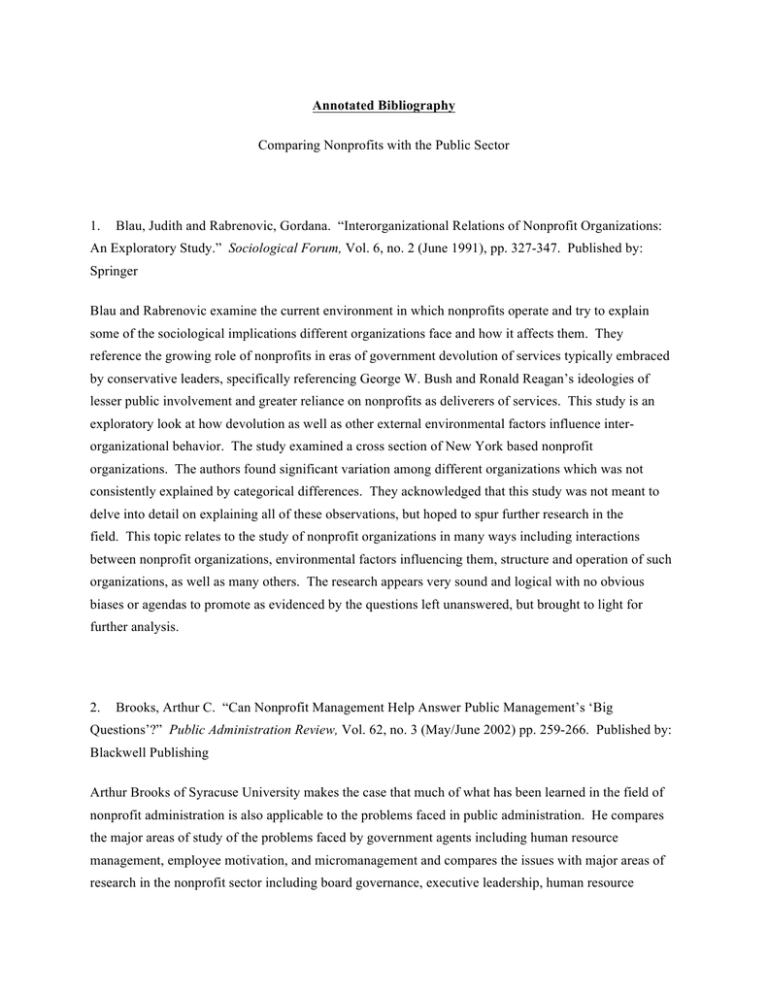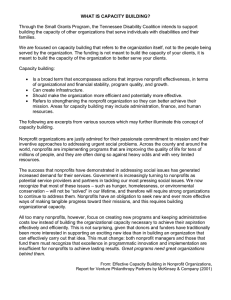Document 11836528
advertisement

Annotated Bibliography Comparing Nonprofits with the Public Sector 1. Blau, Judith and Rabrenovic, Gordana. “Interorganizational Relations of Nonprofit Organizations: An Exploratory Study.” Sociological Forum, Vol. 6, no. 2 (June 1991), pp. 327-347. Published by: Springer Blau and Rabrenovic examine the current environment in which nonprofits operate and try to explain some of the sociological implications different organizations face and how it affects them. They reference the growing role of nonprofits in eras of government devolution of services typically embraced by conservative leaders, specifically referencing George W. Bush and Ronald Reagan’s ideologies of lesser public involvement and greater reliance on nonprofits as deliverers of services. This study is an exploratory look at how devolution as well as other external environmental factors influence interorganizational behavior. The study examined a cross section of New York based nonprofit organizations. The authors found significant variation among different organizations which was not consistently explained by categorical differences. They acknowledged that this study was not meant to delve into detail on explaining all of these observations, but hoped to spur further research in the field. This topic relates to the study of nonprofit organizations in many ways including interactions between nonprofit organizations, environmental factors influencing them, structure and operation of such organizations, as well as many others. The research appears very sound and logical with no obvious biases or agendas to promote as evidenced by the questions left unanswered, but brought to light for further analysis. 2. Brooks, Arthur C. “Can Nonprofit Management Help Answer Public Management’s ‘Big Questions’?” Public Administration Review, Vol. 62, no. 3 (May/June 2002) pp. 259-266. Published by: Blackwell Publishing Arthur Brooks of Syracuse University makes the case that much of what has been learned in the field of nonprofit administration is also applicable to the problems faced in public administration. He compares the major areas of study of the problems faced by government agents including human resource management, employee motivation, and micromanagement and compares the issues with major areas of research in the nonprofit sector including board governance, executive leadership, human resource management, financial resource development, adaptation to change, organizational structure and performance measurement. In his analysis, he briefly addresses the existing research in the public field and goes into greater depth regarding the nonprofit sector in order to make the case that the latter can help clarify and bring perspective to issues in the former. His introduction clearly states that he seeks to prove this point, but he also acknowledges that the interaction of the sectors goes both ways in enlightening both fields. This work is very closely related to our course in nonprofit organizations in that it hits on key issues in many of the same areas we seek to know more about. 3. Callen, Jeffrey L. and Falk, Haim. “Agency and Efficiency in Nonprofit Organizations: The Case of ‘Specific Health Focus’ Charities.” The Accounting Review, Vol. 68, No. 1 (January 1993), pp. 4865. Published by:American Accounting Association Callen and Falk seek to test the hypothesis that nonprofit organizations with a greater ratio of members who originate from outside the organization are more efficient in their delivery of services. This contention is based on prior research and the theory that board members from outside of the organization have greater incentive to monitor the organization while board members from within the organization have a greater incentive to consume perquisites. They test this hypothesis with empirical data research. The research did not support any of their hypotheses. Despite this lack of support for their conjectures, the article explores many areas that can help inform those concerned with organizational efficiency and board leadership in the nonprofit sector. 4. Carson, Emmett. “Public Expectations and Nonprofit Sector Realities: A Growing Divide with Disastrous Consequences.” Nonprofit and Voluntary Sector Quarterly 2002; 31; 429 Emmett D. Carson of the Minneapolis Foundation examines the current divide between public perceptions of what nonprofits are and their proper role in society and the reality of how nonprofits operate and present themselves to society. He invokes early notions of small volunteer based organizations dependent fully on the kindness of individuals in describing how nonprofits have changed and evolved to a much larger scale and how public perceptions have not conformed to the new role played by nonprofits. He mentions specific actions nonprofits must do to confront problems both with their substance and image and makes the case that this is an imminent problem threatening not only the nonprofit sector, but the nature of our democracy as a whole. This article hits on key issues facing us today relating to the nonprofit sector and how modern nonprofit leaders need to react to the disconnect between perceptions and reality. Overall, many conclusions are based on opinion and lend themselves to further empirical research on specific claims. 5. Feigenbaum, Susan. “Competition and Performance in the Nonprofit Sector: The Case of U.S. Medical Research Charities.” The Journal of Industrial Economics, Vol 35, no. 3 (March 1987), pp. 241253. Published by: Blackwell Publishing Feigenbaum examines an often overlooked aspect of nonprofit organizations: intramarket competition and its affect on performance efficiency. She takes into account important considerations such as degree of establishment and size of organizations in developing her model which links market structure, firm characteristics and performance. This particular analysis examines one particular area of nonprofit industry: medical research, however she notes that these findings may apply to other areas such as services for the poor or environmental conservation. She finds that there are links between size and efficiency as well as other determining characteristics both among markets as well as individual firms. Her research seems quite objective and thorough. These findings relate to the study of nonprofits and can confer real-world benefits to those who seek explain differences between organizations in efficiency of delivery of services and relative administrative costs. 6. Feiock, Herbert and Jang, Hee Soun. “Nonprofits as Local Government Service Contractors.” Public Administration Review (July/August 2009), pp. 668-680. Feiock and Jang examine the expanding role nonprofits are playing as joint providers or sole providers of specific services for municipalities. The analysis focuses on elder care as it is one of the most commonly contracted-out services for which local governments rely on nonprofit cooperation. They analyze the governmental factors which influence the degree of contracting for such services and have developed a transaction-cost model which helps determine what type of partnership is most likely, if at all. This particular piece of research fits especially well with my discovery topic and will serve as an important resource. Their analysis includes many factors important to deciding whether municipalities will contract for services and seems to reach sound conclusions. This area of nonprofit research is important and can help determine the best applications of nonprofits as contractors for local governments. 7. Fizel, John and Nunnikhoven, Thomas. “Technical Efficiency of For-Profit and Non-Profit Nursing Homes.” Managerial and Decision Economics, Vol. 13, no. 5 (September/October 1992) pp. 429-439. Published by: John Wiley & Sons Fizel and Nunnikhoven compare the efficiency of non-profit and for-profit nursing homes in their analysis. They use statistical analysis to evaluate whether there is a significant difference between the two and try to explain the reasons why. One contention is that the profit motive naturally encourages greater efficiency and competition within similar organizations. They examine best-practices used by both types of nursing homes and the efficiency with which they use their available labor. They did find statistically significant differences in efficiency favoring their hypothesis that for-profit nursing homes are overall more efficient. They do acknowledge that outcomes are difficult to measure given the intangibility of the care given. However they devise models to measure performance objectively, the reliability of which is left to the reader to distinguish. The results, which are of arguable utility could be useful in definite circumstances and are good food for thought for any nonprofit which competes with private-sector firms. 8. Nielsen, Richard; Peters, Michael; and Hisrich, Robert D. “Intrapreneurship Strategy for Internal Markets-Corporate, Non-Profit and Government Institution Cases.” Strategic Management Journal, Vol. 6, no. 2 (April-June 1985) pp. 181-189. Published by: John Wiley & Sons Nielsen and Peters show us a less well-known internal organization strategy called “intrepreneurship” with potential to increase productivity and efficiency in large organizations either, public, private, or nonprofit. In their case studies, they analyze the application of intrapreneurship at three different institutions including all three of these types of organizations: The U.S. Department of Energy, Texas Instruments, and Harvard University. They acknowledge the limitations of this practice such as its better suitability for secondary organizational activities, better application in larger rather than smaller organizations, its usefulness in rapidly changing environments rather than slowly changing ones, as well as legal constraints. This area of research is particularly germane to the study of nonprofit organizations as more large-scale organizations find themselves with inadequate or inefficient internal management structures. 9. Nunamaker, Thomas R. “Using Data Envelopment Analysis to Measure the Efficiency of Non-Profit Organizations: A Critical Evaluation.” Managerial and Decision Economics, Vol. 6, No. 1 (March 1985), pp. 50-58. Published by: John Wiley & Sons Nunamaker, an Assistant Professor of Accounting and Business Law at Washington State University reminds us of the problems organizations face in measuring their productivity nonprofit to when non-standard output measures exist. This is particularly common in the sector as organizations often do not have direct competitors with analogous outputs measure. His article details how Data Envelopment Analysis can help solve these problems since it is not reliant on such standardized measurements already existing and can help alleviate the problem of output data being skewed by those reporting it. DEA allows previously non-comparable data to be compared easily with other units. This information to the could prove valuable in situations where relative nonprofit performance is important know, especially in decision-making and resource allocation. It also helps us compare effectiveness of organizations among different sectors as my discovery paper intends to do. 10. Reiner, Thomas and Wolpert, Julian. “The Non-Profit Sector in the Metropolitan Economy.” Economic Geography, Vol. 57, no. 1, New Directions in Public Services (January 1981) pp. 23-33. Published by Clark University Reiner and Wolpert conducted a regional study focused on the Philadelphia metropolitan area to determine the relationship between regional growth/decline and the increase/decrease of support for nonprofit organizations from different sources. They analyzed the pattern of giver-recipient transfer and also detailed the main areas of nonprofit giving and how they are affected. They used empirical evidence and theoretical constructs to show us the patterns that occur when regions are in decline. They found support for their theory that when in decline, nonprofits tended to get decreased support from certain sources allowing others to constitute a larger portion of their base funding that would usually be the case. This research has great potential both to benefit nonprofit organizations in how they target their outreach in differing regional environments, but can also be a good indicator of what state a region is in. Many questions were left unanswered however and further research is needed to increase the usefulness of the lessons learned. 11. Schlesinger, Mark; Mitchell, Shannon; and Gray, Bradford. “Restoring Public Legitimacy to the Nonprofit Sector: A survey Experiement Using descriptions of Nonprofit Ownership.” Nonprofit and Voluntary Sector Quarterly (2004); 33; 673 This study analyzes public concerns about nonprofits similar to those examined by Emmett Carson’s “Public Expectations and Nonprofit Sector Realities: A Growing Divide with Disastrous Consequences”. This study devises an experimental design which shows us that increased understanding of nonprofits is correlated with better expectations and higher confidence in their services. It also exposes the fact that faith in nonprofits is especially lacking in minority groups. In its conclusion, the study provides theories on how nonprofits can improve their public perception. This seems to be a recurring theme and a useful one at that. The study has a broad scope and is an important piece of the study of nonprofit organizations. 12. Snavely, Keith. “The Welfate State and the Emerging Non-Profit Sector in Bulgaria.” Europe-Asia Studies,Vol. 48, no. 4 (June 1996) pp. 647-662. Published by: Taylor and Francis, Ltd. Snavely’s study on the welfare state and the role of nonprofits in Bulgaria brings us some much needed perspective on how nonprofits operate in different countries with differing styles of governance and different predominant ideologies as found in former Communist Eastern European states. The role of nonprofits in countries such as these is significantly different than we experience in the developed western world. Snavely points out that while Bulgaria struggles to provide adequate social services, their nonprofit sector struggles as well. With little government input available, the nonprofit sector does not have the resources to flourish. This keeps the two sectors from complimenting each other as they do in more resource-rich countries. Also he notes differences to be expected from the welfare-state model in that preferences for services to be delivered by the government may limit the scope of nonprofit services offered. This piece of research will be invaluable in my discovery paper as the patterns exhibited in Bulgaria may help control for the government influences on American nonprofits.





